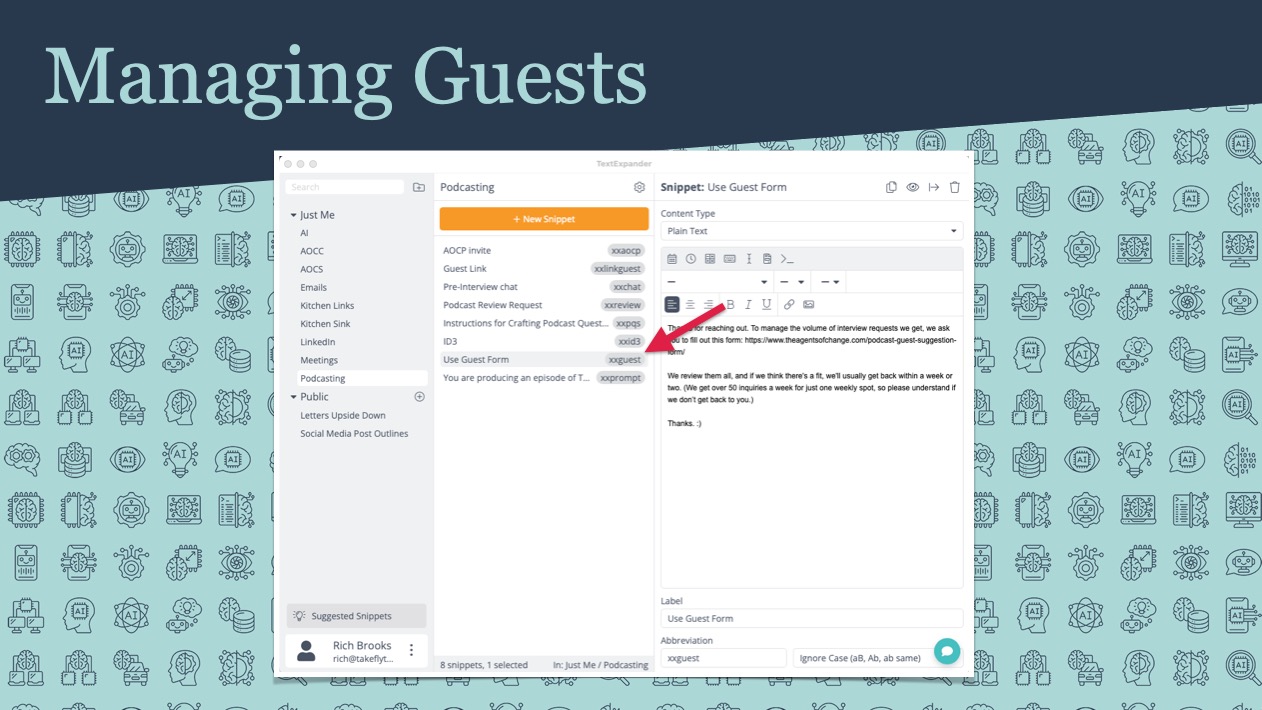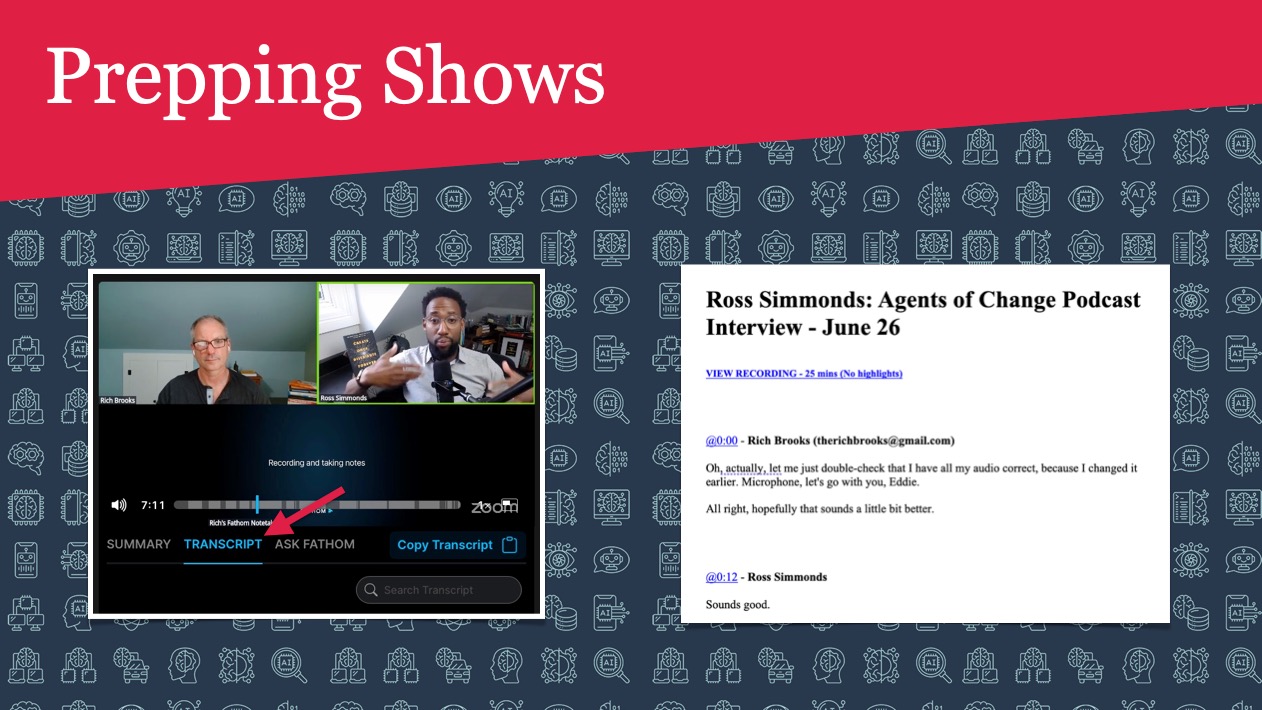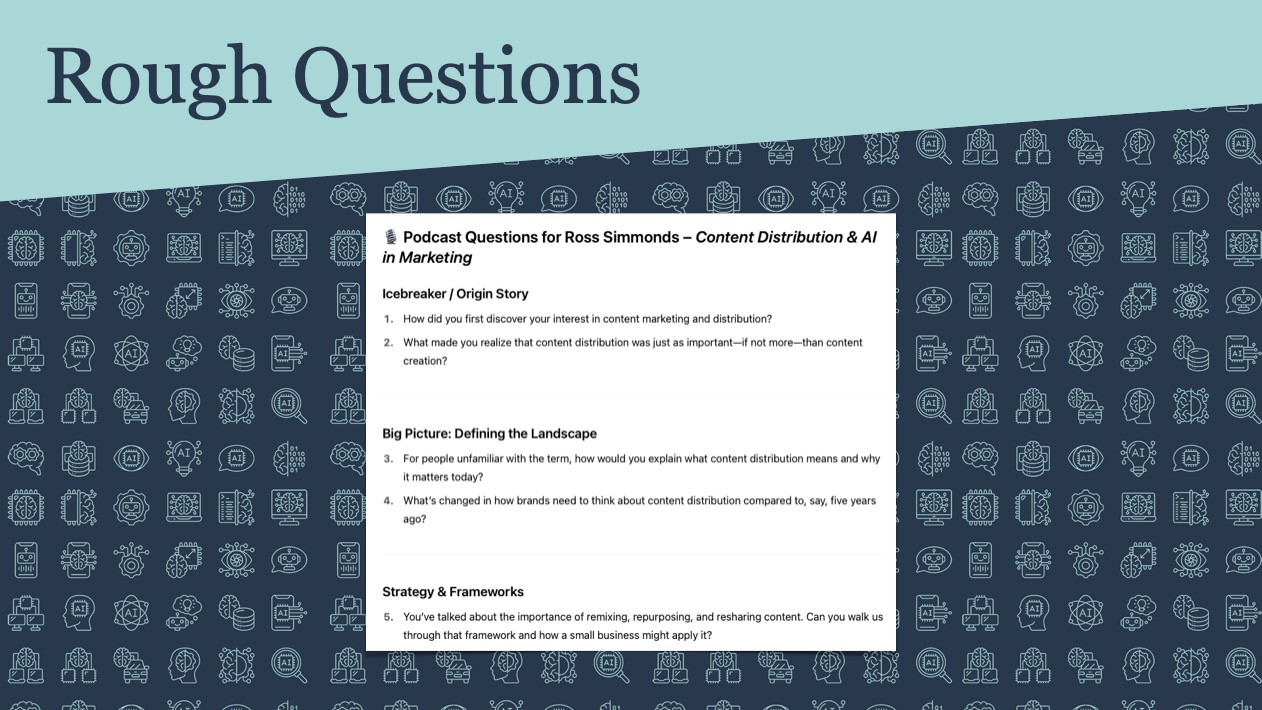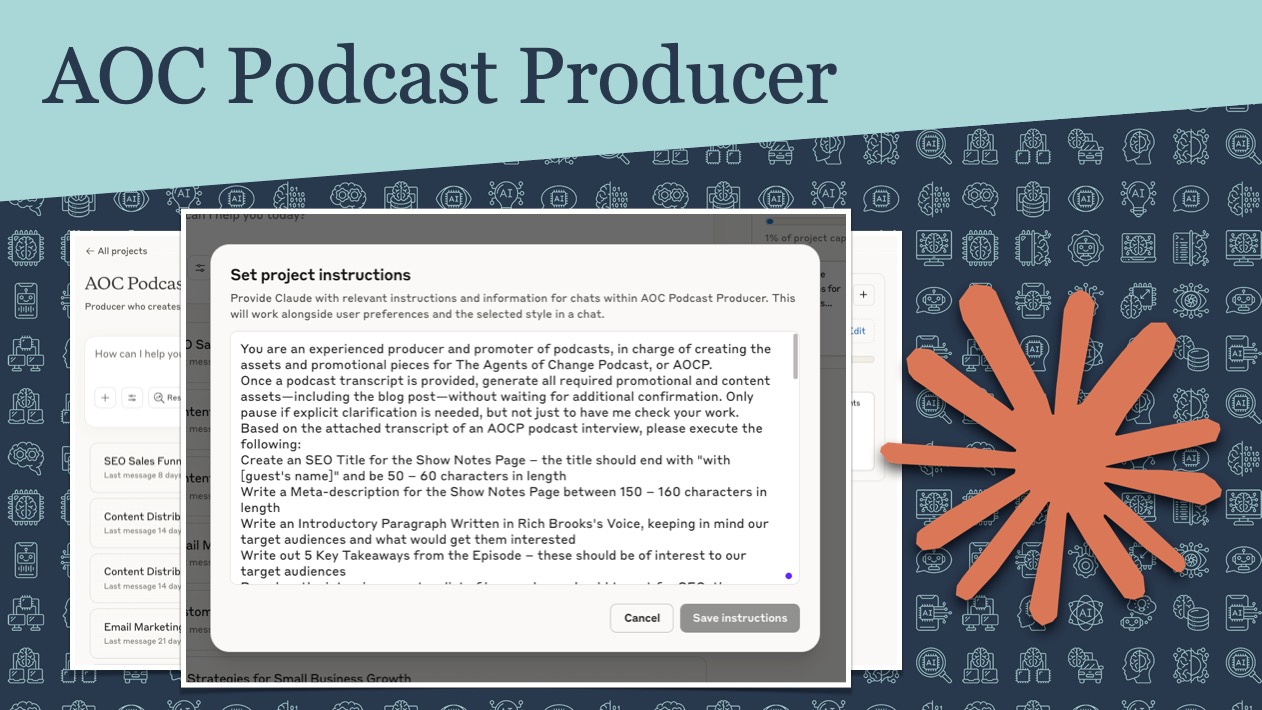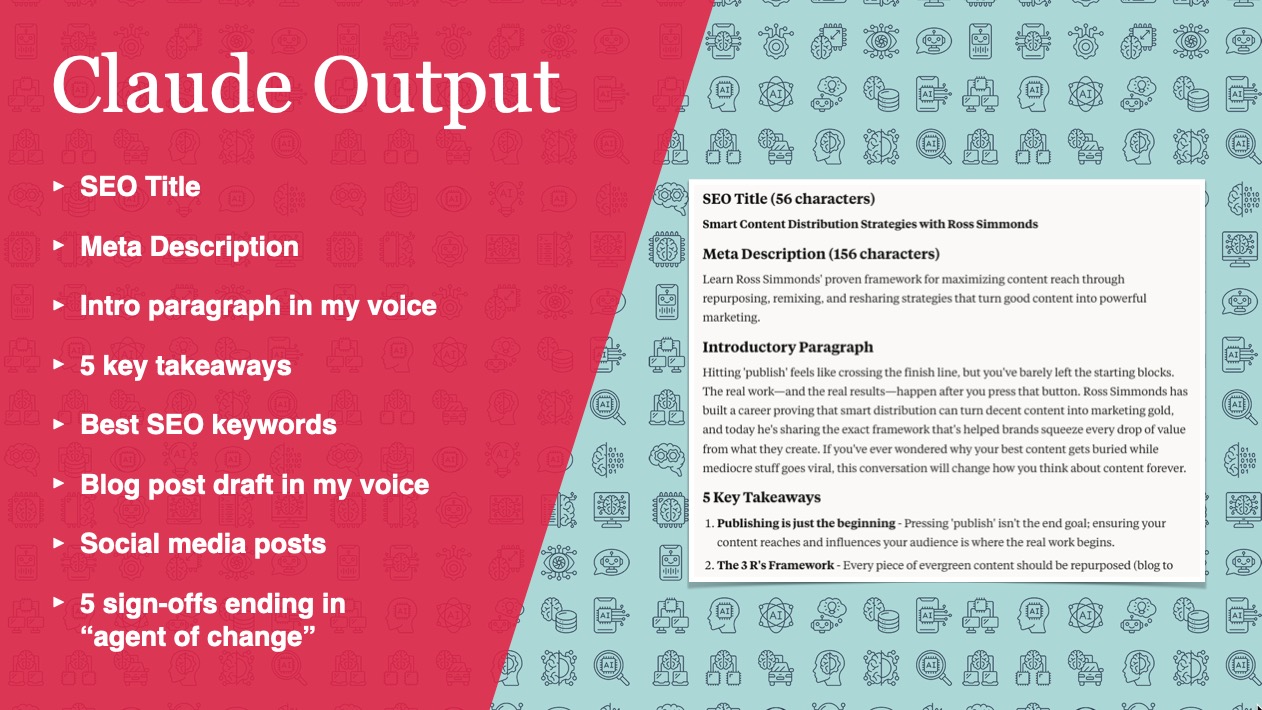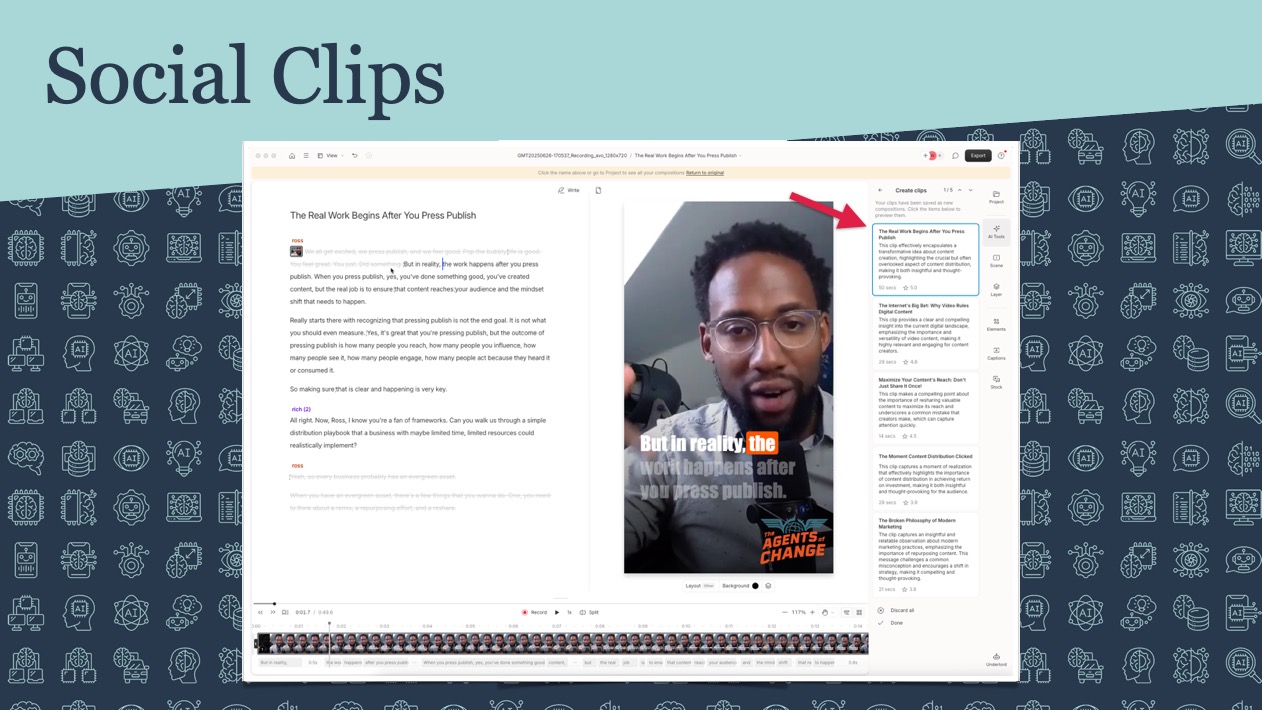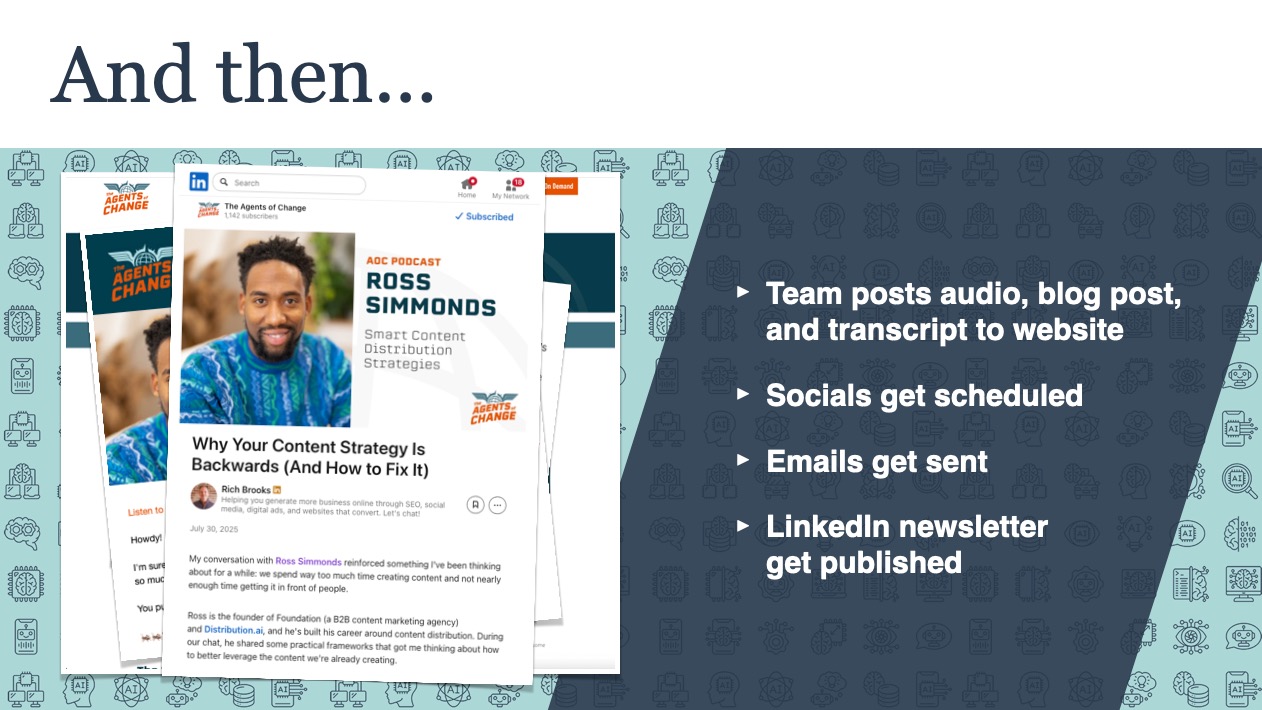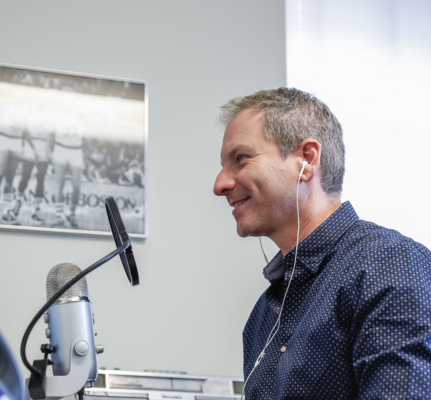

Podcast: Play in new window | Download
After 600 episodes of interviewing digital marketing experts, I’ve learned a thing or two about efficiency. Whether you’re thinking about starting a podcast or just want to see how AI and automation tools can transform your content creation process, this behind-the-scenes look at my current workflow might give you some ideas you can steal for your own business.
How AI and Automation Transformed My 600-Episode Podcasting Workflow
When I hit episode 600 of the Agents of Change Podcast, I felt that familiar pressure to do something big. Something momentous. Something worthy of the milestone. (Cue Ride of the Valkyries.)
Instead, I decided to do something different: pull back the curtain on how I produce this show.
Now, before you click away thinking “I don’t have a podcast,” slow your roll. The workflow I’ve built over 600 episodes uses AI and automation in ways you can absolutely steal for your own content creation—whether you’re writing blog posts, creating videos, or managing any kind of regular content schedule.
The Reality Check: It’s Not Actually One Hour Per Episode
When we got serious about time-tracking at my agency, I discovered something that made me laugh (and cry a little). I’d been telling people the podcast takes about an hour per episode. Turns out, it’s closer to three hours.
But here’s the thing—it’s been one of the most rewarding projects of my career. And with the right systems, those three hours generate way more than just one podcast episode.
The Guest Avalanche (And How TextExpander Saves My Sanity)
I get 25-30 guest requests every week for one interview slot. That’s a lot of rejection emails. Do the math, and you’ll see why I needed a system.
Enter TextExpander, a tool my friend Andy Crestodina introduced me to. Instead of typing the same rejection email over and over, I type “xxguest” and it expands into a full response explaining our process.
It’s polite, efficient, and drops people into a system where the best candidates actually get considered instead of lost in my inbox.
Your takeaway: Look for repetitive communications in your business. Whether it’s client onboarding emails, proposal follow-ups, or social media responses, TextExpander can save you hours every week.
Pre-Interview Calls: The Secret to Better Content
Once someone makes it through our initial screening, I do a 15-minute pre-interview call. This isn’t just about vetting—it’s about building rapport and understanding what makes them tick.
I use Fathom, my favorite AI notetaker, for these calls. It gives me a full transcript and summary, and since I have the paid version, I can ask it questions later. (This is crucial because I’m a terrible notetaker and my memory isn’t much better.)
During these calls, I’m looking for quick, elevator-pitch answers to potential questions. Does this angle work? What gets them excited? Are their methods ethical?
At the end, I almost always say yes. The only times I’ve declined are when I felt their methods were unethical and it wasn’t something I wanted to share under the Agents of Change banner.
Using AI for Question Preparation
Once the pre-interview is done, I grab the transcript from Fathom and drop it into a Word doc. Then I bring in AI.
Using another TextExpander shortcut—”xxpqs”—I upload the transcript into ChatGPT or Claude with specific instructions to turn it into interview questions.
Do I use the AI’s draft as-is? Never. I “zhuzh” it up to make it sound like me—more conversational, more natural. But it saves me time and sometimes gives me fresh angles I wouldn’t have thought of.
Your content application: Try feeding AI your research notes, customer interviews, or even competitor content. Ask it to generate blog post outlines, social media angles, or email subject lines. Just remember—AI gives you the raw material, not the finished product.
Post-Production: Where AI Really Shines
After recording, my assistant (who happens to be my girlfriend—less “virtual,” more “real-world”) takes over. She drops the audio into Descript for transcription, then cleans it up manually because machine transcripts are still far from perfect.
But here’s where my Claude project—the “Agents of Change Podcast Producer”—really shines. It’s an AI assistant trained on my brand voice, my audience, and my workflow.
When I feed it a transcript, it generates:
- SEO keywords
- A keyword-rich title
- Meta descriptions
- Social media posts for different platforms
- Five key takeaways
- A complete blog post in my voice (like this one)
- And more.
Is it perfect? No. Claude loves to end every blog post title with “(and how to fix it),” which gets old fast. But it gives me a starting point that I can edit and refine in a fraction of the time it would have taken me to write from scratch. (It feels very meta that I’m editing this post right now.)
Using AI to Create Repurposed Content for More Platforms and More Reach
Here’s where the real efficiency kicks in. One conversation becomes:
- A podcast episode
- A blog post
- Multiple social media posts
- Vertical video clips (thanks to Descript’s templates)
- A LinkedIn newsletter
- Email content for subscribers
Recently, I started republishing the blog posts as LinkedIn newsletters on Fridays. In just a few months, that list has grown to about 1,200 subscribers—proving that the same content can find new audiences in different formats.
The Tools That Make It All Work
Let me break down the key players in this workflow:
- TextExpander: Saves hours on repetitive typing
- Fathom: AI notetaking for all calls (not just podcast-related)
- Calendly: Automated scheduling that integrates with Zoom
- Descript: Transcription, editing, and vertical video creation
- Claude AI: Content generation trained on my brand voice
- BareValue: Professional post-production team
Each tool handles specific parts of the process, and they all work together to turn one conversation into multiple pieces of content.
What You Can Steal for Your Own Workflow
Even if you never plan to start a podcast, there are tactics here you can apply:
- Automate repetitive communications and prompts with tools like TextExpander
- Use AI notetakers for client calls, team meetings, and research interviews
- Train AI assistants on your brand voice for content generation
- Create content templates that turn one piece of work into multiple formats
- Build systems for quality control instead of hoping everything works out
The Bottom Line
Yes, this workflow takes 2-3 hours per episode instead of the one hour I originally thought. But those hours generate way more value than just a single podcast episode.
More importantly, the systems and automation mean I can focus on what matters most: having great conversations and creating content that helps people grow their businesses.
Whether you’re creating content for social media, writing blog posts, or building any kind of regular publication schedule, the principles are the same. Build systems, leverage AI for the heavy lifting, but always add your human touch to make it authentically yours.
The goal isn’t to replace human creativity—it’s to amplify it. (Well put, Claude!)
How to Streamline Your Podcast Workflow with AI Episode Transcript
Welcome to another episode of The Agents of Change podcast. The podcast that’s here to help you reach and engage your ideal customers online. My name is Rich Brooks, I’m your host, and this is episode 600, powered by flyte new media.
I couldn’t be putting out this podcast for the past 600 episodes, about 12 years of content, without the help of my team. From website design to social media promotion, email marking to content creation, I am blessed to have a team that can do it all, and they can do it for you too. Whether you need help with branding with a website that generates high quality leads, search engine optimization, paid search, paid social, they really can do it all. So if you need a plug and play team to grow your business, reach out to us at takeflyte.com or theagentsofchange.com, and I will personally get back to you.
As I mentioned on a previous episode, I was recently out in Cleveland at CEX, the Content Entrepreneur Expo. As part of one of my presentations there, I talked about how I use AI in my podcasting workflow. Now since this is episode 600, and I tend to have this habit of whenever I hit one of these double zero episodes that I have to do something big and something memorable, well, rather than overthink it, I thought that you might be interested in getting a better understanding of how I use AI and other tools in my podcasting workflow.
And even if you’re not a podcaster, don’t really intend to add podcasting to your marketing, I think you’re still going to get a lot out of this episode to see how you can use AI and other tools into whatever marketing workflow you may have.
Let’s start by talking about how I bring on guests. After 600 or so episodes, I get a lot of requests from people who want to come on the show. And in the last several years, there’s also been a real upswing in agencies that are specifically looking to get their clients booked on podcasts. I’d say I get on average 25 to 30 requests every week to come on the podcast for just one slot, and that doesn’t even include when I do solo episodes like this one, or when I read a blog post or an article and then I really want to interview the person who wrote it. Or I have a friend who I think is brilliant and I just want to bring them on the show and share their brilliance with you.
So in short, maybe there’s a one in 50 chance of someone getting on the show who requests it. And as you can imagine, that’s a lot of rejection letters to write. So one tool I use is called TextExpander, which my friend Andy Crestodina told me about. It’s not an AI tool, but it creates text shortcuts. So I use it in a lot of different ways. Basically, every time somebody emails me to come on the show or their podcast booking agent trying to get their guest on or get their client on, I just hit ‘reply’ and type out XX Guest. So for me, whenever I type out xx, that’s the beginning of a short code that I use in TextExpander, just because it’s not something that I would normally type out in regular typing. So in this case, XX Guest expands into a message that says, “Thanks for reaching out. To manage the volume of interview requests we get, we ask you to fill out this form.” There’s a link. We review them and if we think there’s a fit, we usually get back to you in a week or two. And then I let them know that there’s usually about a one in 50 chance of them actually getting on the show. Thank you very much. Smiley face. And that puts them into the process.
So once they fill out the form that I direct them to, all of those forms go to my VA, who also happens to be my girlfriend. So I guess she’s not actually a virtual assistant, she’s a real-world assistant. She goes through the request, and she knows the kind of guests and the topics that I’m looking for. She knows the kind of content that you’d be interested in, and then she listens to some of the samples from podcast interviews or YouTube interviews that they’ve been on, which is part of the submission process. And then she kind of vets them and puts together a smaller list of guests that she thinks would be valuable for the show.
Then she sends them to me through a spreadsheet. I review them. I listen to the excerpts of the previous interviews they’ve done, and I decide who I want to bring onto the show. Then I get back to them. I go to the original email, and I set up a 15-minute pre-interview chat by typing out XX Chat in the response, which basically welcomes them to come on for a pre-interview chat and gives them a link to book a time. So they click on that link, they go to my Calendly, they pick a time. It books space on my calendar, and it also creates the Zoom link for the interview. Now we’ve got the pre-interview chat scheduled.
We both show up on the Zoom call, and I use Fathom at this point. Fathom is my favorite AI note taker to date. I just feel it does an excellent job. I love that it gives me both a summary of the call as well as a full transcript, and since I have the paid version, I can even ask questions afterwards if I want to of Fathom about what the podcast was about.
I use Fathom also for all of my sales calls at flyte. We use it for all our internal calls. It’s just this amazing tool that fills in the gap, since I have a terrible memory and I’m a terrible note taker. So Fathom has been one of the most important AI tools that I’m currently using in any of my workflows. So we have this 15-minute pre-interview chat. I don’t ask them for full answers. I just want the elevator pitch. Is this a good question? Is this not a good question?
It also gives us a chance to get to know each other. I find that these pre-interviews are especially helpful if I don’t know the person. We can build rapport. I get to understand them better, get a sense of what excites them about the subject and so on. We talk for about 15 minutes, and almost invariably at this point, I say ‘yes’ to the guest. That actually sounds like a reality TV show. “Say yes to the guest”. The only times I ever say ‘no’ are when I feel the topic we’d be discussing is unethical. I’ve had a few people who reach out to me, and they talk about this great way that they can get email subscribers or YouTube views, and then when I get them on the pre-interview chat and they explain their process, it feels really sketchy to me, and that’s not what we’re about on The Agents of Change podcast.
I feel that marketing should really be a very ethical endeavor. But 99% of the time I say, hey, I’d love to have you on. They say ‘yes’, and we take it to the next step, where I send them an email with the booking link. Again, it goes through Calendly, it goes through Zoom, and the process continues.
Now, I am thinking about changing the process. I mean, after 600 episodes, I’ve gone through a lot of evolutions about how all of this comes together. I’m considering moving away from Zoom and going to Descript, because Descript actually has some built-in podcasting tools like Riverside.fm. It records separate local tracks for both me and the guest, and then merges them, which gives a higher quality recording. I just haven’t worked a script into my automated process yet, but hopefully before episode 700, I’ll have that figured out.
All right, so now we move into preparing for the show. Prepping the show starts with going back to Fathom. I grab the transcript of the pre-interview chat. I drop it into a Word doc, and I save it. Then I bring in AI. I’ll upload the transcript to ChatGPT or sometimes Claude. And I use Text Expander again, this time with the short code I call xx PQS. And that’s short for ‘Podcast questions’. So that expands into instructions telling the AI to take that pre-interview transcript and turn it into a series of questions that I can ask my guest in the instructions. It talks about the style I’m looking for, my voice, the kind of questions that we want to be asking. In general, this is a one-time prompt that I can reuse over and over again regardless of whether we’re talking about SEO or email marketing or neuro marketing.
Now before AI, I would’ve just taken my notes during the chat and then tried to turn them into questions. And I can still do that. But this step, this process saves me a ton of time, and sometimes AI comes up with questions that I wouldn’t have thought of, but still in my voice, because I’ve trained it to do so. I also give it instructions, or in the instructions I tell it how to order the questions, how to build upon the previous questions, and I include some favorites of mine, like a contrarian question near the end, or an origin question near the beginning.
Now, I don’t take the output verbatim. You never should. When it comes to AI, I get the output, then I juzz it up so it sounds more like me. Even though I’ve trained it, it’s not exactly how I would ask these questions, so I make it more conversational, more natural. Sometimes instead of a pre-interview, a guest will send me a recent blog post or article, especially friends that I’ve invited on. We might skip the 15-minute call. In those cases, I use an AI tool called Sider. It’s a freemium tool. It’s a Chrome plugin that you can use that will summarize any webpage.
So I’ll go to the blog post. It pulls out an abstract, it pulls out key points, and I can ask you questions about the article, and it will even suggest other related questions. So depending on the situation, I’ll use the pre-interview transcript, Sider, or both, to build out the questions. Then I finalize them and get ready for the interview.
Okay, it’s the big day. It’s time for the interview. It’s time to record this show. As I mentioned, right now I’m using a mixture of Zoom with Fathom, although I am looking into switching over to Descript now. The recording itself is the easiest part. I’ve got the questions in front of me. I have their bio, which they provided as part of the process. I’ve got the guest, so I do the introduction. I ask the questions, and we hopefully have a great conversation. We record the show, and I let the guest free and they go off and do whatever they do.
Now once the recording is done, we move into post-production. I take the audio file, and I send it over to my VA. She drops it into Descript to get the machine transcript, but those are still not perfect. She goes through it and cleans it up. She does this for several podcasts. She’s really good at it. In fact, if you’re listening and you have a podcast and you’re not happy with the quality of your transcripts, reach out to me. I’ll get you a friends and family deal with her. She also does some extra work for me as well.
And yes, AI has gotten better and better, and it can do some of this now, but I still feel that she does a better job than AI at this point. For these extras, she’ll pull in a good bumper quote, track down links for products or websites that the guest mentioned, and all of those go into the show notes. She’ll also suggest a title, give me an intro paragraph, and then note any edits like, “Hey, at the 20 minute mark, the guest sneezed and we had to go back and ask the questions”, so I know to go in and edit that part out. So from her, I get a polished transcript, editing notes, a proposed title, intro, and a bumper quote, as well as some other odds and ends.
And at this point, this is really where the AI magic happens. I’ve created a Claude project called, The Agents of Change Podcast producer. It’s a full set of instructions that tells Claude to take the transcript and create all kinds of assets for the show. It finds the SEO keywords, it creates a keyword rich title for the show notes, it writes up a meta description. It gives me an intro paragraph that I can use for the ID3 tags. It writes up social posts, email, subject lines, signoffs, and the five biggest takeaways. You name it. Anything we need for the post-production and promotion of the show. All happens through this AI assistant that I’ve created.
It also writes a blog post in my voice based on what I learned during the episode, which then I use as a rough draft. So here’s why I do that. One of the things that I realized over the years is even though we’ve got a full transcript of the show, most of our episodes don’t rank very well in search. And my working theory is that when you have every single word that a guest and a host speak, there’s not a lot of consistency. Like, yes, they might be talking about the subject, but they’re often going off on tangents. You never speak as clear as you write. So that’s always been my working theory that transcripts seem like they should be good for SEO, but they’re just not as polished and easy for the search engines to understand as say a concise series of show notes or blog posts written about the same subject.
So based on that, I started to create blog posts on what I learned during the podcast. So that’s why I do this process. So it creates this blog post in my voice based on what I learned from the episode, which then I use as a rough draft. Now it’s not perfect. So for example, almost every week Claude suggests a title for the blog post that ends in “and how to fix it now”. Once a year, sure, that’s a great title. That’s a great way of doing it. But every single week is just annoying. So I clean it up.
Sometimes, if the changes I want are big, I’ll feed my edits back into Claude and ask Claude to compare the version it wrote versus the version I wrote and give me a summary of what those changes are. And then we sometimes go back and forth on whether there’s enough of a mistake that I should go back in and update the instructions or update the knowledge document that is in the assistant. So again, there’s a lot of iteration with these tools so that I can continually make them better and better.
After I’ve got the cleaned-up blog post, I create the intro and outro for the show, then I upload everything, audio, text, metadata to Barevalue, my post-production team. And that’s Barevalue, BARE value.com. They’re fantastic. I assume they’re overseas from America, but wherever they are, they do excellent work. When I make a mistake, they often catch it, fix it, or let me know so that I can upload an updated version of the audio. Just a really great team at this point.
I also use another TextExpander shortcut, XX ID3, which creates a template for the ID3 tags, which is some of the metadata that goes into the podcast. I type in the information, much of which I get from Claude, and then we send it all over to Barevalue. A few days later, the finished product comes back.
Recently, we’ve also added vertical videos for social promotion. So I take the Zoom video, upload it into Descript, strip out all the ‘ums’ and ‘ahs’, and ask it to find five clips that I can use for social media. Sometimes I guide it with keywords. Sometimes I let it decide for itself using a template that I created in Descript.
It generates polished vertical videos, all 30 seconds or so long. They’re usually about 95% to 100% percent ready. I just pick the two or three that I like, and I send them off to my team. From there, my team handles the rest, uploading the episode, uploading the blog post, the show notes, everything to the website. They put together the social promotions into our production calendar and make sure that everything’s in place.
Some weeks, if I have time, I’ll also record a quick 30-second vertical video of myself and post that on social. We also send an email to our subscribers, so that goes out. My team takes care of that for me. And then on Friday, since the show drops on Wednesdays, I repurpose the blog post that was written as a LinkedIn newsletter. It takes me about five or 10 minutes to prep, and then I publish it on Friday morning. And in just a couple months of doing this, we’ve built up a list to about 1,200 subscribers on LinkedIn. So without a whole lot of extra work, it’s just a great way to reach a wider audience.
Now, if you’re listening to this and you’re thinking to yourself, wow, that is a lot of work and a lot of time, and a lot of moving parts to go into each episode. Well, you’re right. In fact, when we recently started time tracking at flight tracking every single thing we do, including my own work, it was eye-opening because in my mind, up until that point, I spent about an hour per episode, which was basically the podcast interview itself, along with the pre-interview chat, and that was it.
But when I started tracking everything I do, I realized that most weeks I spend two and a half to three hours per episode. And over 600 episodes, as you can imagine, that definitely adds up. That’s not insignificant, especially since I’m the main rainmaker for flyte. That’s a lot of opportunity, cost, a lot of things that I could be doing during those two and a half to three hours each week to grow my business.
So is it worth it? I would say it’s absolutely worth it. Over these last 600 episodes, I have learned so much. I’ve had so many amazing conversations. I’ve reconnected with friends who I wouldn’t really have an opportunity to connect with otherwise, but I get them to come on the show and it’s an opportunity to reconnect with them.
And yes, the podcast has even generated business for flyte. We’ve had listeners who reach out to me who want help with their branding or web design or digital marketing, and so it’s been a feeder for flyte as well. Overall, it’s been a great experience. So while it does take time, it’s been one of the most rewarding projects of my career.
So again, if you want to see the slides that I put together for CEX that kind of informed this episode, you can do so at our website. Again, it’s theagentsofchange.com/600, you’ll find the show notes, the transcript, the links, the blog post I just talked about. Everything you need to better understand how you can create an effective workflow for your podcast or anything else that you’re looking to do with the power of AI.
So I want to thank you for sticking with me through this episode through episode 600 and for the 600 episodes that we’ve created, and I hope you’ll stick with me for another 600. Together, we’ll keep learning, keep connecting, and keep becoming Agents of Change.
Rich Brooks is the President of flyte new media, a web design & digital marketing agency in Portland, Maine, and founder of the Agents of Change. He’s passionate about helping small businesses grow online and has put his 25+ years of experience into the book, The Lead Machine: The Small Business Guide to Digital Marketing.



